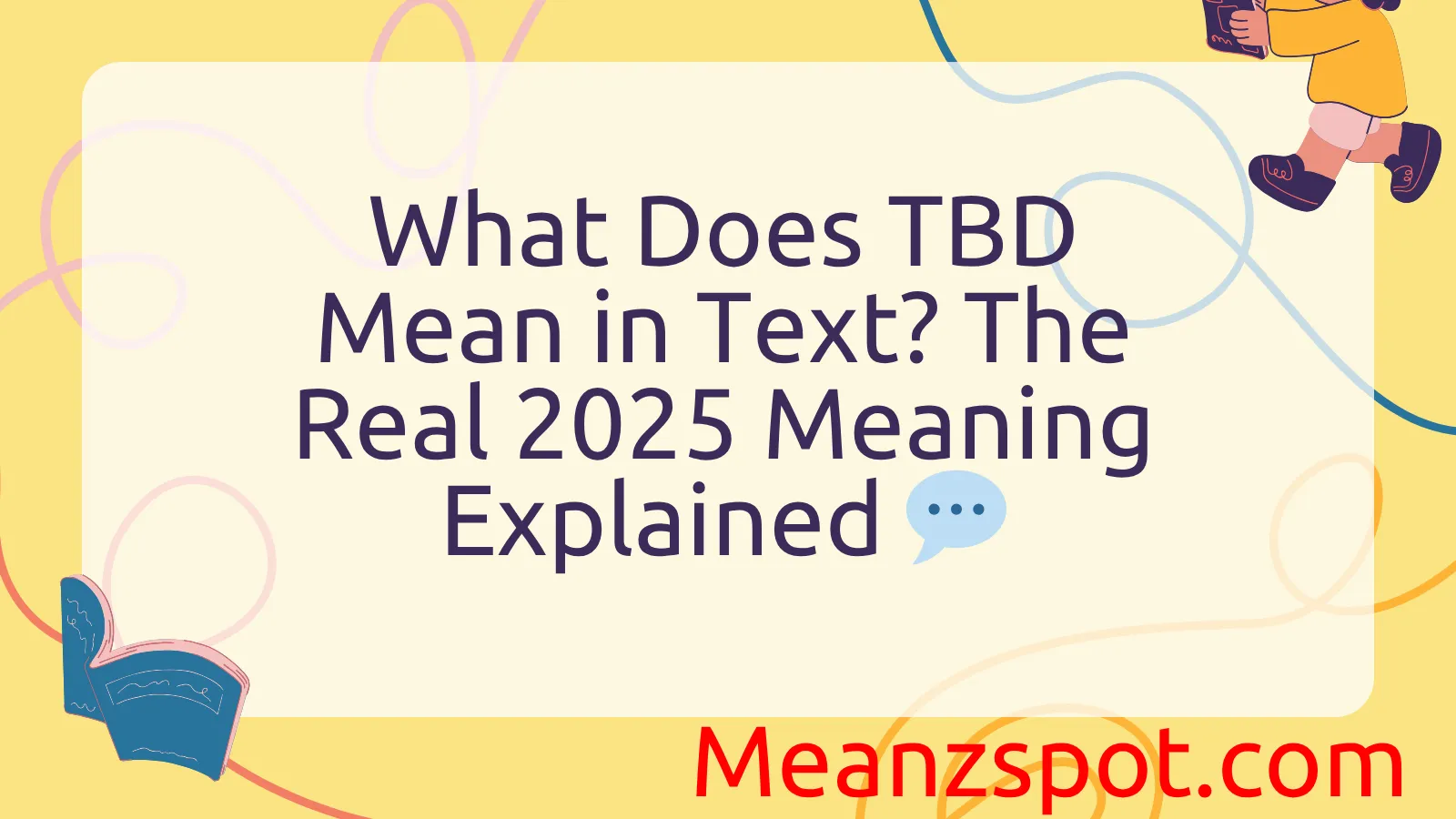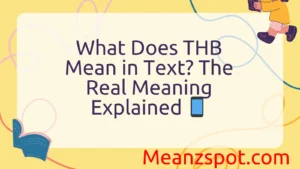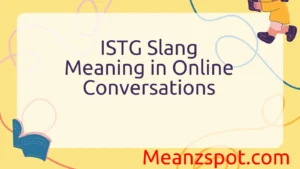If you’ve come across the acronym TBD in a text, email, or social media post and wondered what it means, you’re not alone! In 2025’s fast-paced digital world, this term is still one of the most commonly used abbreviations in both casual chats and professional messages.
The main meaning of TBD is “To Be Determined” — a phrase used when something hasn’t been decided yet. You’ll often see it in plans, schedules, or online posts when details like time, date, or location are still pending. For example: “Party this weekend — time TBD!”
But with the rise of Gen Z texting slang, TBD can also take on playful or sarcastic tones. Sometimes it’s used in a flirty or mysterious way, like “Future plans? TBD 😉.”
Definitions & Meaning
TBD stands for “To Be Determined.” It’s used when a specific detail—usually a date, time, location, or final decision—is not yet finalized but will be decided later. The acronym communicates that the matter is pending and encourages others to stay tuned for updates.
Here are some everyday examples:
- Text Message:
“Hey, the dinner time is still TBD. I’ll let you know once Sarah confirms.” - Event Invite:
“Annual Office Party – Location: TBD.” - Work Email:
“We’ll meet next week (day TBD) to discuss the final budget.”
In all these cases, the acronym acts as a placeholder. It signals that the sender is aware the information is incomplete but plans to follow up.
TBD can apply to:
- Dates & Times: When events haven’t been scheduled.
- Decisions: When choices are under review.
- Plans: When final details need coordination.
In summary, TBD is a temporary status marker. It’s not a refusal or indecision; it’s simply a pause button.
Origins & History
The phrase “To Be Determined” has been used in formal and professional contexts for decades, particularly in scheduling and event planning. However, the shorthand version “TBD” rose to prominence with the advent of digital communication and project management tools in the late 20th century.
Timeline of Usage
- Early 1900s: “To be determined” appears in academic and legal writing to indicate pending outcomes or undefined variables.
- 1970s–1980s: The phrase becomes standard in sports schedules (e.g., “Opponent: TBD”) and TV listings.
- 1990s: With the rise of email and corporate memos, the abbreviation “TBD” gains traction as a time-saving tool.
- 2000s–present: TBD becomes a staple in texts, tweets, and digital planners, used by both professionals and casual users.
The rise of project management software like Microsoft Project, Asana, and Trello helped standardize TBD as a common placeholder. It allowed teams to note a task, milestone, or meeting that lacked a final detail but was on the radar.
Over time, TBD evolved from a formal planning term to something you might see in a group chat about a weekend getaway. Its versatility and brevity made it perfect for the fast pace of modern communication.
Usage in Different Contexts
TBD may look simple, but its usage shifts depending on the context. Let’s break it down.
1. Social Media & Texting
In casual conversations, TBD helps signal flexibility. It shows that plans aren’t locked in but will be soon.
- “Movie night? TBD depending on work.”
- “Time for the BBQ: TBD. Waiting on weather.”
On platforms like Twitter or Instagram, people often use it in captions to keep followers updated:
- “Road trip playlist: TBD 🎶”
- “Big announcement coming—date TBD!”
2. Professional Communication
In offices, TBD carries a bit more weight. It’s used in agendas, calendars, and project timelines to show items needing confirmation.
- “Q3 Meeting – Location TBD”
- “Marketing strategy rollout: Timing TBD based on product launch.”
It’s a subtle way to admit something’s unfinished without appearing unorganized.
3. Pop Culture
TV shows, sports events, and award ceremonies often use TBD when dates or details aren’t set yet.
- “Season 3 Premiere: TBD”
- “Game 5 Start Time: TBD”
Fans recognize this as “stay tuned” language—something exciting is coming, but the details are in the works.
4. Event Planning
When you see TBD on a party invite, RSVP card, or event flyer, it usually means the host is still coordinating with others or securing a venue.
- “Wedding Reception: Venue TBD”
- “Start Time TBD – subject to availability”
This helps keep communication open without canceling or postponing the whole thing.
Common Misunderstandings & Clarifications
1. “TBD” vs. “Canceled”
Some people assume TBD means something might not happen at all. That’s not true. TBD means the event or decision will happen, but details are pending.
2. TBD Isn’t an Excuse
TBD shouldn’t be used as a way to dodge decisions or commitments. In professional settings, overusing TBD without follow-up can suggest poor planning.
3. TBD vs. TBA vs. TBC
- TBD (To Be Determined): A specific detail hasn’t been finalized.
- TBA (To Be Announced): The detail has been decided, but it’s not public yet.
- TBC (To Be Confirmed): Awaiting approval or confirmation from others.
Example:
- TBD: “We haven’t picked a date yet.”
- TBC: “Waiting for venue to confirm availability.”
- TBA: “We know the date but will announce it next week.”
4. Not Always About Time
People often associate TBD with timing, but it can refer to any undecided element: speakers at a conference, a product name, or even pricing.
Alternatives & Synonyms
If you’re tired of saying TBD or want a more tailored tone, here are some alternatives:
Casual Synonyms
- Still figuring it out
- Will update soon
- Pending
- Not set yet
Example:
“Brunch time? Still figuring it out.”
Professional Synonyms
- Subject to confirmation
- Awaiting finalization
- Tentative
- Forthcoming
Example:
“Client meeting – date tentative, will confirm shortly.”
Creative Variations (especially for social media)
- Stay tuned!
- More details coming
- TBA (To Be Announced)
- TBC (To Be Confirmed)
Using the right version depends on your audience. For coworkers, “tentative” may sound more polished than “TBD.” In a group chat, “still deciding” might come across friendlier.
Frequently Asked Questions (FAQ)
1. What does TBD mean in a text message?
It means “To Be Determined.” The sender is letting you know that they’ll decide or confirm something later.
2. Is TBD the same as canceled?
No. Canceled means something won’t happen. TBD means it will happen, but a specific detail hasn’t been set.
3. Can TBD refer to things besides dates and times?
Yes. TBD can apply to locations, names, decisions, or any detail that’s undecided.
4. Is TBD formal or informal?
It works in both settings. In texting, it’s casual. In business, it’s often used in schedules and reports.
5. What’s the difference between TBD and TBA?
TBD means a decision hasn’t been made. TBA means it has been made but hasn’t been shared yet.
6. Can I use TBD in a school assignment or essay?
Usually no. In formal writing, spell it out: “to be determined” or say “will be decided later.”
7. How should I follow up on a TBD item?
It’s perfectly fine to ask for updates. Example: “Hey, just checking in—has the time for Friday been confirmed?”
Conclusion
TBD may only be three letters, but it plays a big role in how we plan, communicate, and keep things moving. Whether you’re coordinating a casual hangout or a corporate meeting, knowing what TBD means—and how to use it—can help prevent confusion and streamline communication.
By now, you know that TBD stands for “To Be Determined,” but it also represents flexibility, ongoing plans, and intent to follow through. Recognizing its meaning across different settings—from texts and tweets to meeting invites—makes you a more effective communicator.



